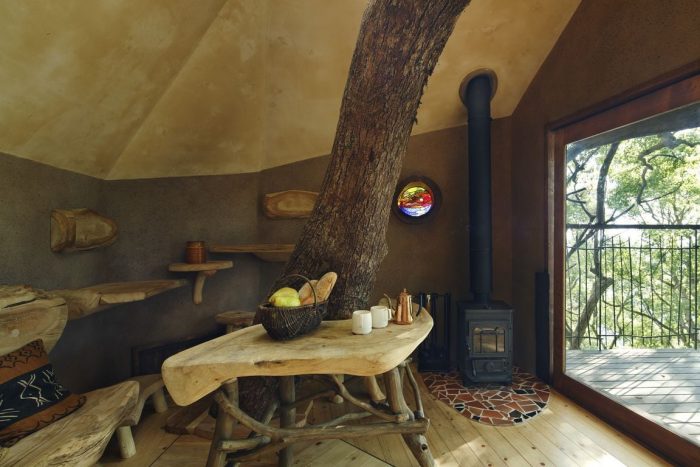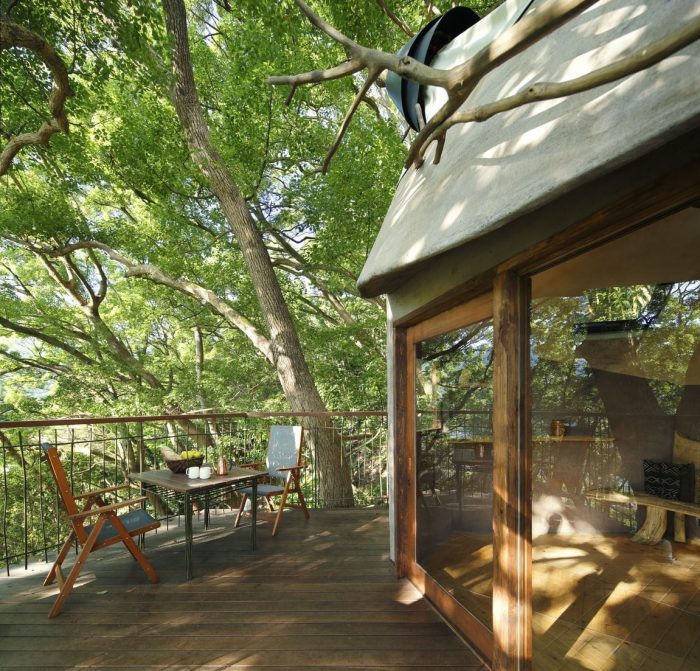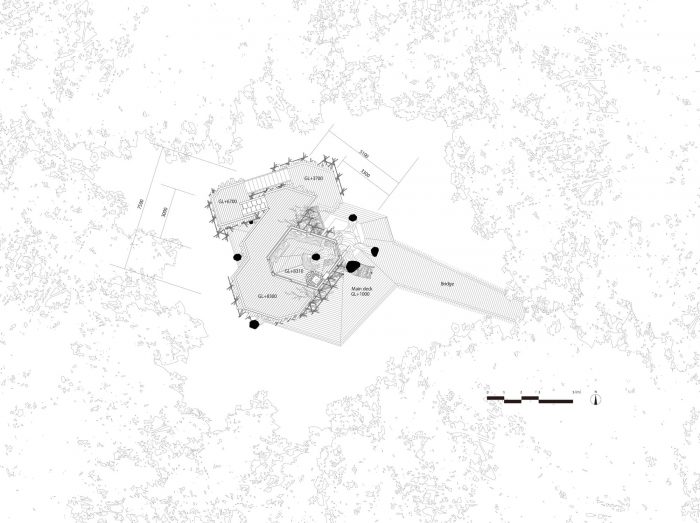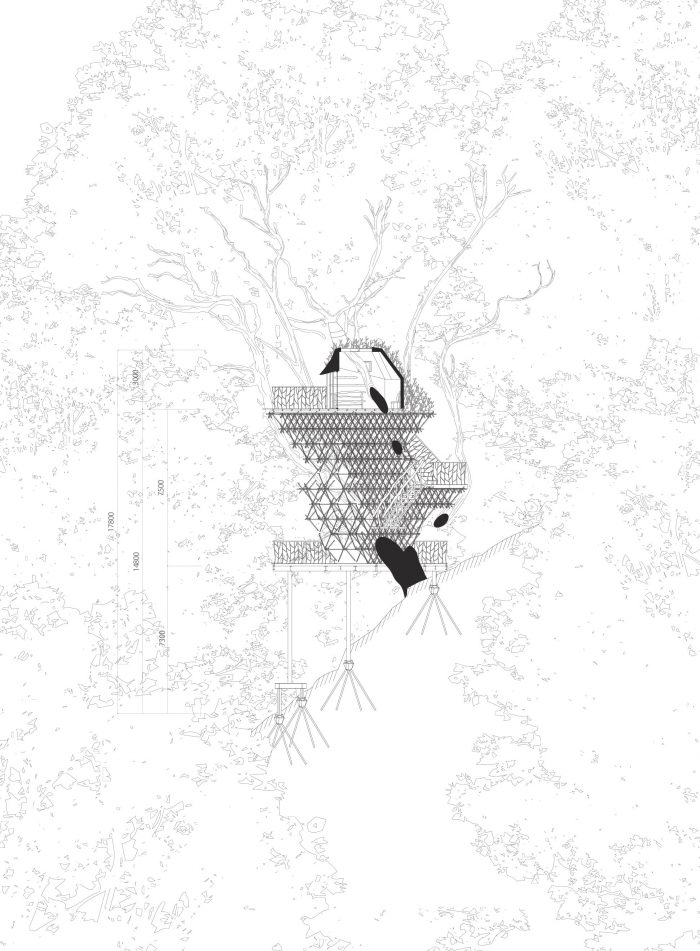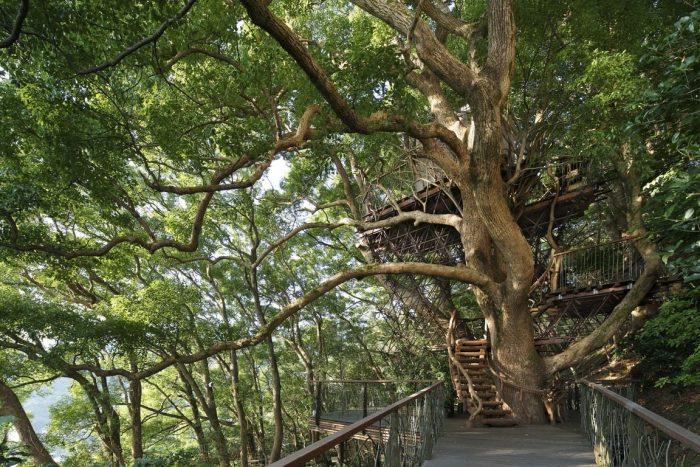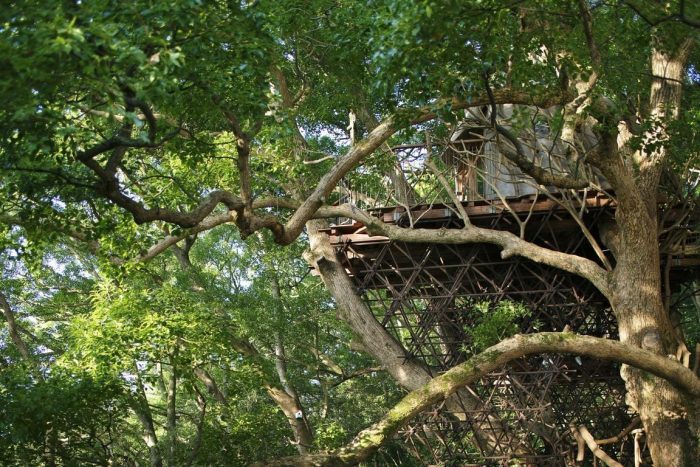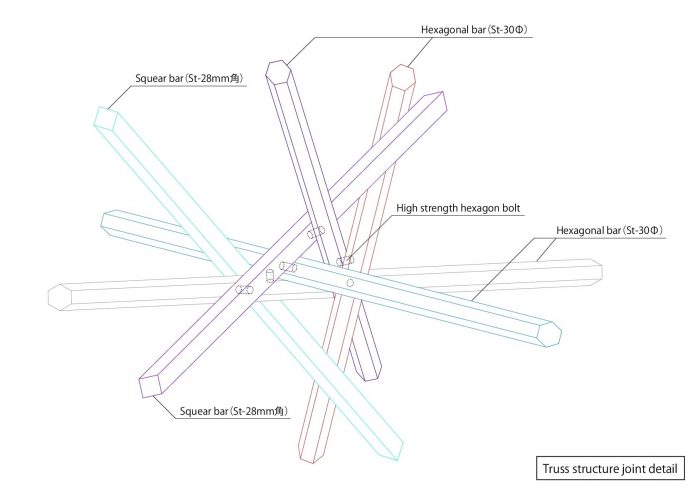我经常被乌鸦用衣架搭建的鸟巢所震撼。衣架不仅耐用,而且有很强的弹性,它们比树枝提供了更多的连接钩,因此更容易组装。乌鸦灵巧地飞过自然和人工的二分法,正在创造一个实用和舒适的环境。
I am often struck by the nests that crows build using clothes hangers. Hangers are not only durable but also highly elastic, and they offer more hooks to connect than branches and hence are easier to assemble. Crows, flying deftly across the dichotomy of natural and artificial, are creating a functional and comfortable environment.
当我正在考虑如何制作一个像那些衣架窝一样的建筑时,我收到了树屋建造者Takashi Kobayashi的请求。他们希望有一个10平方米以下的茶屋作为 “RISONARE热海 “的展示品,这是星野度假村新建的一个运动区。主体树是一棵树龄超过300年的大樟树,周长6米,高22米,供奉在茂盛的原始森林中,俯瞰大海。作为一个面向公众的设施,我们认为它在结构上应该是安全的,而且容易解释,因此我们决定创建一个独立的建筑,不以任何方式接触这棵树。
When I was thinking about how I would like to make a building like those hanger nests, I received a request from Takashi Kobayashi, a tree house builder. A tea house of 10m2 or less was desired as the showpiece of “RISONARE Atami,” a new athletic zone built by Hoshino Resorts. The host tree was a great camphor tree over 300 years of age, 6m in girth and 22m tall, enshrined in a lush, virgin forest overlooking the ocean. It being a facility for the general public, we thought it should be structurally safe and easy to explain, hence we decided to create an independent building that does not touch the tree in any way.
然而,场地是一个陡峭的斜坡,重型机械无法进入,而且房子本身必须建立在离地面10米高的复杂交错的树枝之间。因此,为了能够使用轻型结构件进行人力施工,我们选择了一种采用直径为3厘米的方形和六角形实心钢棒的结构。通过连接这些棒子的表面,我们构建了一个由坚固的六角形螺栓固定在两点的桁架。对于地基,我们在根部之间小心翼翼地插入了墩柱式地基,以避免使用混凝土和大规模开挖。利用结构本身作为脚手架,我们像鸟儿筑巢一样避开树枝进行组装,根据结构分析添加或取出部件。我们将房间内部用石膏固定,使其像一个燕子的巢。这个设计为游客留下了可能性,他们可以通过从山边捡起树枝并将其装入墙内来体验筑巢。外部外观和内部空间有一种温和舒适的气氛,反映了建造者的身体尺度。
The site, however, was a steep slope inaccessible to heavy machineries, and the house itself would have to be established among complexly intertwined branches 10m above ground. Therefore, to enable construction by manpower using light structural members, we chose a composition employing square and hexagonal solid steel rods, 3cm in diameter. Assembling the rods by connecting the surfaces, we constructed a truss held at two points by strong hexagonal bolts. For the foundation, we carefully inserted pier type foundations between the roots in order to avoid the use of concrete and large-scale excavation. Using the structure itself as scaffolding, we assembled it by avoiding the branches as birds create their nest, adding or taking out components based on structural analysis. We mortared the room interior to be like a swallow’s nest. The design leaves open the possibility for visitors to experience nest building by picking up branches from the mountain side and fitting them into walls inside. The exterior appearance and interior space have a gentle and comfortable atmosphere reflecting the bodily scale of the builders.
它是由小到可以携带的部件交织在一起的建筑。建筑可以灵活地适应树的形态(相对于 “场地形态 “而言),并融化在挤满黑枝的森林中。
It is architecture assembled by intertwining components small enough to carry. The architecture can adapt flexibly to the tree form (as opposed to “site form”) and melts into the forest crowded with dark branches.
Architects: Hiroshi Nakamura & NAP
Area : 10 m²
Year : 2014
Photographs :Koji Fuji / Nacasa & Partners Inc
Manufacturers : Hinoki Cypress, Japanese Ash, Japanese Cedar, Plastering Mortar
Structural Design : Arup
Contractor : Takashi Kobayashi & Treehouse Creations
Collaboration : Treehouse Creations
Main Structure : Steel Three-Dimensional Truss
Upper Structure : Timber Framework
Foundation : Diamond Pier
Site Area : 65,000 m2
City : Atami
Country : Japan


